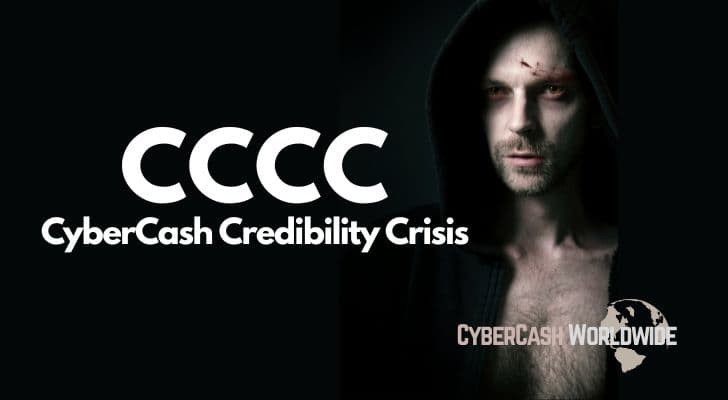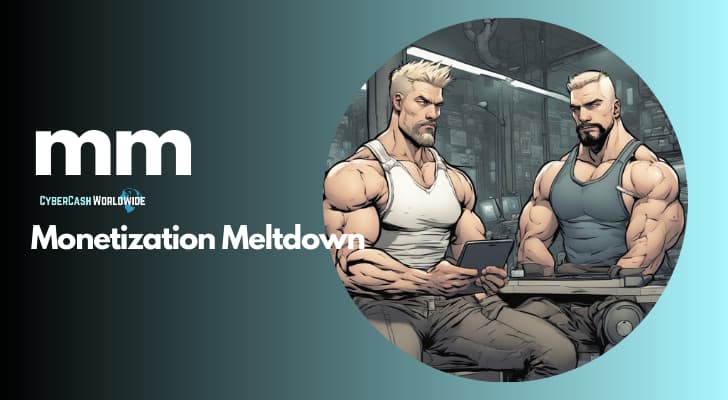Let's get one thing straight right off the bat - CyberCash Worldwide isn't trying to steal your grandmother's pension money or sell you some miracle weight-loss tea that tastes like disappointment. We're just another blogging website floating around in the vast ocean of internet mediocrity, desperately trying to stay relevant while the digital world moves on without us.
The real kicker here is that blogging itself has become about as trendy as flip phones and MySpace profiles, which makes our entire existence like we're running a typewriter repair shop in 2025. Sure, we publish content about cryptocurrency, financial technology, and digital payment systems, but let's be honest - you probably shouldn't trust a word we say because the whole blogging industry is deader than disco.

Is CyberCash Worldwide Actually a Scam?
No, CyberCash Worldwide isn't a scam in the traditional sense of taking your money and disappearing into the night like some sketchy cryptocurrency exchange. We don't sell products, collect credit card information, or promise you'll make millions by following our investment advice. The site operates as a standard blogging platform that generates revenue through advertising and affiliate marketing, which is completely transparent and legitimate. We're not running any Ponzi schemes or trying to trick you into buying worthless digital tokens.
The confusion comes from the word "scam" being thrown around too loosely in online discussions about financial websites. People often label any financial content they disagree with or find unhelpful as a "scam," even when no actual fraudulent activity is taking place. CyberCash Worldwide falls into the category of potentially misleading or unreliable content rather than outright fraud. The real issue lies with getting financial advice from random bloggers on the internet.
However, calling us "trustworthy" would be a stretch bigger than claiming Bitcoin will hit a million dollars next week. The financial advice and cryptocurrency analysis we publish comes from writers who may not have professional qualifications or real-world trading experience. Our content often lacks proper disclaimers about the risks of following investment advice from unregulated sources. Most tellingly, the rapidly changing nature of cryptocurrency markets makes our articles outdated almost immediately after publication.
Red Flags That Make People Suspicious
A couple of factors make visitors question our legitimacy:
- Affiliate links to trading platforms buried within educational content
- Generic stock photos instead of real team member photos
What CyberCash Worldwide Is NOT
Real scams typically exhibit these characteristics that CyberCash doesn't:
- Demanding upfront payments for "premium" investment strategies
- Promising guaranteed returns with no risk disclosure
- Creating fake testimonials from supposed successful investors
- Pressuring visitors to invest immediately before missing "limited time" opportunities
- Collecting personal financial information or login credentials
The Trust Problem with Financial Blogging
The fundamental issue with sites like CyberCash lies with credibility in a space where bad advice costs people money. Financial bloggers often lack the professional oversight and regulatory compliance required of licensed investment advisors. Most blog readers don't realize that following investment advice from unqualified sources carries the same risks as taking medical advice from random internet strangers. The lack of accountability means bloggers face no consequences when their predictions prove wrong or their advice leads to losses.
Why Blogging Died a Slow, Painful Death

Blogging used to dominate online content creation, back when people actually had the patience to read articles longer than a social media caption. Traditional blogs served as destinations for in-depth analysis, thoughtful commentary, and detailed explanations of complex topics that couldn't be condensed into a meme or a 15-second video clip. The glory days featured regular readers who bookmarked their favorite sites and checked back daily for new posts, creating genuine relationships between writers and their dedicated followers.
The shift happened gradually at first, then suddenly accelerated when search engines began prioritizing fresh, frequently updated content over well-researched, evergreen articles that took weeks to craft properly. Social media platforms started keeping users within their walled gardens, making it harder for external blog posts to gain traction organically. Algorithm changes systematically destroyed the organic reach that independent blogs once enjoyed, forcing websites to play an endless game of SEO chess against opponents that change the rules monthly.
Content creators realized they could build larger audiences by posting quick updates and reactions rather than investing time in comprehensive articles that would get buried in the digital noise. The economics shifted from rewarding quality to rewarding quantity and speed. Most successful "bloggers" now operate like social media influencers who occasionally write longer posts rather than traditional writers who happened to publish online.
How Search Engines Killed Blog Traffic
Google's algorithm updates systematically destroyed organic reach:
- Featured snippets now answer questions directly in search results without requiring clicks
- Video results appear above text-based articles for most queries
- Local business listings push blog content further down the page
- Sponsored content receives premium placement over organic articles
- Knowledge panels deliver instant information without visiting source websites
The Attention Span Apocalypse
Modern internet users have been conditioned to expect instant gratification:
- Average person scrolls through hundreds of social media posts daily
- Brain training for rapid, superficial information processing instead of deep reading
- Video content holds viewer attention better than text-based articles
- Even 500-word blog posts feel like major time commitments
- Competition for eyeball time has intensified beyond traditional media boundaries
Why Social Media Won the Content War
Social platforms restructured how people discover and consume information:
- Instagram stories deliver bite-sized updates throughout the day
- TikTok videos explain complex concepts through visual demonstrations
- LinkedIn posts reach professional audiences directly
- Facebook groups create discussion spaces that blogs cannot replicate
- Real-time feedback and discussion that static blog posts simply cannot match
The CyberCash Credibility Crisis

The financial technology space moves faster than a caffeinated day trader, making any blog content obsolete before the digital ink dries on the virtual page. Cryptocurrency markets fluctuate wildly within hours, regulatory frameworks shift monthly, and new payment platforms launch daily - all while we're still editing last week's article about Bitcoin trends that are already completely irrelevant. Digital payment systems evolve so rapidly that by the time we finish researching and writing a comprehensive guide, three new companies have disrupted the entire industry landscape.
The democratization of online publishing has flooded the internet with so much financial advice and cryptocurrency analysis that distinguishing between credible sources and random speculation has become nearly impossible. Every teenager with a Robinhood account now considers themselves a fintech expert, flooding Medium and Substack with half-baked theories about market movements and investment strategies. The barrier to entry for creating financial content online is practically nonexistent, meaning readers must wade through thousands of unqualified opinions to find genuinely useful information.
Traditional gatekeepers like established financial institutions and certified analysts have lost their monopoly on authoritative financial commentary, creating a wild west of digital financial advice. The financial incentives for promoting certain cryptocurrencies or investment platforms create inherent conflicts of interest that compromise the objectivity of much financial blogging content. Readers have become rightfully suspicious of any financial advice they encounter online, knowing that the person writing the article probably gets paid to promote specific products or services.
Signs That Financial Blog Content Lacks Credibility
Several red flags indicate unreliable cryptocurrency and fintech blog content:
- Authors who don't disclose their trading positions or potential conflicts of interest
- Price predictions without proper risk disclaimers or probability assessments
- Technical analysis that ignores fundamental market factors and news events
- Promotional language that sounds like marketing copy rather than educational content
- Missing publication dates that make it impossible to judge information timeliness
How Fast-Moving Markets Outpace Blog Publishing
The lag time between market events and published blog analysis creates several problems:
- Cryptocurrency prices swing 20% while articles are being written and edited
- Regulatory announcements change the legal landscape before blogs update their advice
- New blockchain projects launch and fail within typical blog publishing timeframes
- Technical developments make previous analysis completely obsolete within weeks
- Market sentiment shifts faster than traditional publishing schedules accommodate
The Expertise Problem in Financial Blogging
Most financial bloggers lack the professional qualifications necessary to give reliable advice:
- No formal education in finance, economics, or investment analysis
- Limited real-world trading experience with large amounts of money
- Insufficient knowledge of regulatory requirements and compliance issues
- Tendency to confuse personal opinions with data-driven analysis
- Failure to acknowledge the limitations of their own knowledge and experience
The Monetization Meltdown

Traditional blog monetization strategies have become increasingly ineffective as ad-blocking software, banner blindness, and privacy regulations have decimated display advertising revenues across the internet. Affiliate marketing has saturated most niches to the point where readers automatically assume that any product recommendation comes with financial incentives rather than genuine endorsement. The rise of subscription-based content platforms has fragmented audiences across multiple paywalled services, making it harder for individual blogs to build sustainable revenue streams.
Content creators now need to diversify across multiple platforms and revenue streams to make blogging financially viable, which dilutes their focus and content quality. The cost of producing high-quality blog content has remained constant while the potential revenue has declined dramatically, creating an unsustainable economic model for most independent bloggers and small publishing operations. Professional editing, graphic design, research time, and technical maintenance all require investments that are difficult to recoup through traditional blog monetization methods.
Blog owners have become increasingly dependent on external platforms like Google and Facebook for traffic, creating vulnerability when algorithm changes or policy updates suddenly reduce organic reach and visitor numbers. The centralization of internet traffic through a few major gatekeepers means that bloggers must constantly adapt to changing platform requirements rather than focusing on creating valuable content for their readers. Social media platforms eliminate years of audience-building work with a single account suspension or algorithmic change that reduces content visibility.
Why Traditional Blog Revenue Streams Dried Up
Several factors have made blog monetization increasingly difficult:
- Ad blockers prevent display advertisements from generating revenue
- Cookie restrictions limit targeted advertising effectiveness
- Affiliate link disclosures reduce conversion rates
- Increased competition drives down advertising rates
- Platform policy changes eliminate revenue streams overnight
The High Cost of Quality Content Production
Creating professional blog content requires investments:
- Professional writing and editing services for error-free articles
- Graphic design and image licensing for visual appeal
- Research subscriptions and data access for accurate information
- Technical hosting and security measures for reliable website performance
- Search engine optimization consulting to maintain visibility
Alternative Revenue Models That Actually Work
Successful content creators have shifted to sustainable monetization strategies:
- Online courses that teach specific skills with lifetime value
- One-on-one consulting services that command premium hourly rates
- Membership sites that deliver ongoing value through exclusive content
- Speaking engagements and workshop facilitation fees
- Product endorsements and sponsored content partnerships with clear disclosure
The Future Belongs to Everything Except Blogging

Modern learners increasingly prefer visual and interactive content over text-heavy explanations, making video tutorials and infographic summaries more effective educational methods than traditional written articles. Complex financial concepts that require thousands of words to explain in a blog post get demonstrated clearly through screen recordings, animated graphics, or step-by-step video walkthroughs. The multisensory nature of video content helps viewers retain information better than reading alone, especially for technical subjects that benefit from visual demonstrations.
Social platforms allow content creators to showcase their personalities and build connections with their audiences, while blog writing often feels impersonal and detached from the actual human behind the content. Followers develop parasocial relationships with creators they see regularly in videos or social media posts, creating trust and loyalty that translates into higher engagement rates. The behind-the-scenes content and personal stories that social media enables help humanize financial and technical topics that otherwise feel dry or intimidating.
The viral nature of social media content means that truly valuable information reaches massive audiences organically, while blog posts rely on search engine optimization and external promotion to find their readers. Hashtags, shares, and algorithmic recommendations help social media content find its intended audience more efficiently than the traditional blog discovery process of search queries and website bookmarks. Content creators build personal brands and direct relationships with their followers through social media interactions, creating loyalty and engagement that transcends any single piece of content.
How Social Media Changed Content Discovery
The way people find information has shifted dramatically from search-based to algorithm-fed:
- Facebook and Instagram feeds surface relevant content without active searching
- TikTok's algorithm learns user preferences and suggests related financial content
- LinkedIn's professional network shares industry insights through peer recommendations
- YouTube's suggested videos create educational pathways through related content
- Real-time trending topics highlight current discussions about market events
Why Visual Learning Beats Text-Heavy Blog Posts
Modern audiences respond better to multimedia educational content:
- Screen recordings show exactly how to use cryptocurrency trading platforms
- Animated charts explain market trends more clearly than static graphs
- Video personalities create trust through facial expressions and vocal tone
- Interactive polls and quizzes test comprehension better than passive reading
- Live streams allow for real-time questions and immediate expert responses
The Personality Factor in Financial Education
Social media allows content creators to build relationships with their audiences:
- Behind-the-scenes content humanizes complex financial topics
- Personal trading stories create relatability and trust with followers
- Mistakes and learning experiences demonstrate honesty and vulnerability
- Real-time reactions to market events show genuine expertise under pressure
- Direct messaging enables personalized advice and mentorship relationships
The Blogging Graveyard: Nobody Reads Our CyberCash Nonsense Anymore
The blogging industry has become a digital ghost town where content creators continue publishing articles that fewer and fewer people have the time, attention, or inclination to read completely. CyberCash Worldwide represents everything wrong with contemporary online publishing - we're producing content about rapidly changing topics using a medium that's too slow to keep pace with the subjects we're trying to cover. The fundamental mismatch between how content is created and how audiences actually consume information has created an unsustainable publishing ecosystem that benefits nobody.
So is CyberCash Worldwide a scam? Not in the legal sense - we're not stealing money or running fraudulent schemes. But calling our content "trustworthy" or "reliable" would be dishonest given the inherent limitations of financial blogging in today's rapidly evolving digital landscape. The real scam would be pretending that random blog posts about cryptocurrency substitute for proper financial education and professional investment advice.
The death of blogging reflects deeper changes in human behavior and attention patterns that make traditional long-form content feel increasingly obsolete. While we'll probably keep publishing articles because that's what we've always done, the honest truth is that you'd be better off getting your financial technology news from social media, your cryptocurrency analysis from YouTube, and your investment advice from licensed professionals who actually know what they're talking about.
How I "Finally" Make Over $7,000 Monthly Income
"The most valuable thing I've ever done!"

